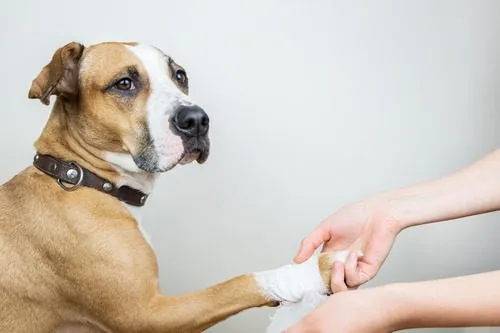What to Do if Your Dog Has a Puncture Wound
Puncture wounds in dogs can happen quickly and unexpectedly, whether it’s from a bite, a sharp object, or even a scuffle at the dog park. While they may appear small on the surface, these injuries often involve more damage beneath the skin than pet owners realize. Because of how easily bacteria can get trapped in these wounds, timely veterinary attention is essential. If your dog has a puncture wound, knowing what to expect and how to respond can make a big difference in their recovery. Below, we’ll cover what may cause these injuries, the signs to watch for, and what steps to take next. If your dog has a puncture wound in Parrish, FL, call Parrish Veterinary Clinic & Urgent Care at (941) 216-2335 or request an appointment online for expert care.

What Is a Puncture Wound in Dogs?
Puncture wounds are narrow, deep injuries caused by something sharp piercing the skin. Unlike abrasions or shallow cuts, these wounds go below the surface and often affect the tissue underneath. Because the opening may appear small, many pet owners underestimate the seriousness of these injuries. In reality, they can lead to infection, abscesses, or even damage to internal structures depending on their location.
Common sources of puncture wounds in dogs include bite wounds from other animals, sharp sticks or thorns during walks, nails, fencing, or tools in the yard. While puncture wounds can happen anywhere on the body, injuries near the chest, eyes, abdomen, or joints should be considered especially urgent due to the potential for internal damage.
How to Tell If Your Dog Has a Puncture Wound
Recognizing a puncture wound may not be straightforward, especially when the fur hides the entry point. If you suspect your dog has a puncture wound, look for subtle but telling signs of trauma. Depending on the location and severity, your dog might react differently.
Physical Symptoms to Watch For
If your dog has a puncture wound, common physical symptoms include:
- Bleeding or oozing from a small opening
- Swelling or bruising around the site
- Sensitivity or pain when the area is touched
- Licking, chewing, or scratching at the site
- Presence of pus or foul odor (a sign of infection)
Behavioral Changes That May Indicate Pain
Even if a puncture isn’t visible, changes in your dog’s behavior can suggest something is wrong:
- Sudden limping or favoring one leg
- Reluctance to be touched or picked up
- Unusual quietness or hiding
- Loss of appetite
If any of these signs appear and you suspect your dog has a puncture wound, contact your veterinarian promptly.
Why Prompt Veterinary Attention Matters
A puncture wound may look minor but can carry serious health risks if left untreated. Bacteria introduced during the injury often become trapped below the skin, which can lead to abscesses or infections. Some punctures can penetrate muscle, nerves, or even vital organs, depending on the depth and location. Even if bleeding is minimal, internal damage could be present. For example, a small puncture on the chest could cause lung collapse, or a bite wound on the leg could injure tendons or joints. Having your veterinarian evaluate the injury right away helps minimize complications and ensures your dog receives appropriate treatment.
At Parrish Veterinary Clinic & Urgent Care, we use diagnostic tools, wound cleaning protocols, and pain management plans tailored to your dog’s condition. Call (941) 216-2335 if you suspect your dog has a puncture wound that needs immediate care.
Common Causes of Puncture Wounds in Dogs
Puncture wounds can result from many everyday scenarios. While some can be avoided, others happen in a split second.
Bite Wounds from Other Animals
Dog bites are among the most common causes of puncture wounds. These injuries often occur during fights or rough play. Even if the wound appears minor, bites can trap bacteria under the skin and should always be examined by your vet.
Outdoor Hazards Like Thorns and Sticks
Running through brush or wooded areas exposes dogs to sharp objects like thorns, splinters, or broken branches. These objects can easily pierce the skin, especially on the paws, legs, or face.
Household or Yard Accidents
Dogs can step on nails, get caught on wire fencing, or run into tools left in the yard. Even a routine walk through the garage or around the neighborhood can present risks. Knowing the most common sources of puncture wounds helps you take preventive measures. But when accidents happen, quick action is key.
What to Expect at Parrish Veterinary Clinic & Urgent Care
If your dog has a puncture wound, our veterinary team will begin with a full exam to determine the depth and extent of the injury. Depending on what we find, additional diagnostics such as X-rays or ultrasounds may be recommended especially if the injury is near the chest, abdomen, or a joint.
Steps Your Veterinarian May Take
- Wound cleaning: The wound will be thoroughly flushed to remove debris and reduce bacteria.
- Antibiotics: If infection is present or likely, antibiotics may be prescribed.
- Pain relief: Your dog may receive medication to relieve discomfort.
- Drainage or minor surgery: In some cases, a drain may be placed to allow fluid to escape.
- Follow-up care: Your veterinarian will provide instructions on how to monitor healing and what symptoms to report.
Prompt evaluation helps reduce the risk of complications and promotes a smoother recovery.
Tips for Preventing Puncture Wounds in the Future
While it’s not possible to prevent all injuries, you can take steps to reduce the likelihood of your dog experiencing a puncture wound.
Safety Tips at Home and Outdoors
- Check your yard for sharp objects, exposed nails, or broken fencing.
- Keep your garage organized and tools stored out of reach.
- Supervise outdoor play and walks in wooded or brushy areas.
- Monitor interactions with other animals, especially during playtime.
- Consider using boots or protective gear on hikes if terrain is rough.
When in Doubt, Seek Veterinary Care
If your dog has a puncture wound or you think they might have one, don’t wait to act. Even small wounds can lead to bigger problems if bacteria or foreign material remain beneath the skin. A professional evaluation can identify complications early and begin treatment before issues escalate. At Parrish Veterinary Clinic & Urgent Care, we’re here to help you handle these situations with confidence. Our team provides compassionate, timely care for dogs with puncture wounds and other urgent health concerns. Call (941) 216-2335 or request an appointment today if your dog shows signs of injury. Early attention makes all the difference.
